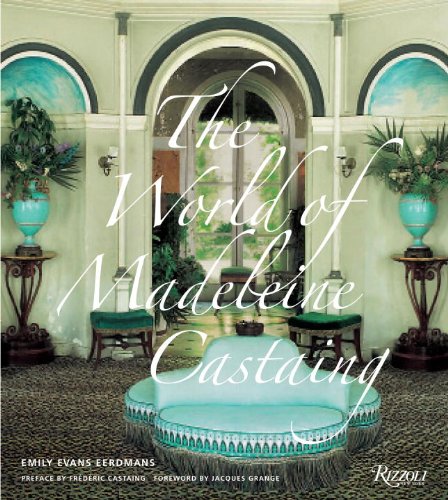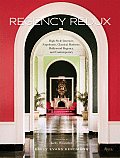 |
| Charlotte Moss in her Upper East Side garden - MC would have adored this indoor/outdoor space; photo by Mark Heithoff |
EEE: When did you have your first Castaing experience?
CM: Oh my gosh. It was probably on one of my first trips to
There were some things I was interested in and I introduced myself. She acknowledged that, we chatted and that was that. And then I probably saw her a couple of other times when I was on trips. For me, she was such a goddess and her store was like being in a temple.
 |
| The Bibliotheque at Leves: Moss carried off the Napoleon III X-form chairs and the reading stand in the archway |
 |
| Castaing chic for everyone! Moss had this quintessentially Castaing chair reproduced |
She was famous for refusing to sell things.
There were no prices on anything. Remember, she was the first one who ever did a shop where – it’s tough to even call it a shop – it doesn’t do it justice... It was if you walked into someone’s salon and it felt like you were intruding. It was almost like you had gone to someone’s house and you got busted opening the medicine cabinet or caught opening a drawer, you know what I mean?
And she would have a fire going and a tea cup perched here and there...
She was having tea in some mistmatched number – fabulous – I thought – oh my God – my grandmother did that! And French women do it too. All these things start to line up for you. When your grandmother did it, well of course that was your grandmother and when your parent tells you something, you think yeah, yeah, yeah – but when you see someone else do it, it’s immediately validated.
Were you able to buy things from her?
I don’t remember if I actually bought anything – maybe a pair of candlestick lamps with shades. I remember I was interested in a screen one time and she had some fabulous ceramics… that would have been the kind of thing I would have bought. I wouldn’t have bought any upholstered furniture because the prices were crazy. But years later I did end up buying things at the auction.
 |
| One of a pair of stools embroidered with Madeleine and Charlotte's initials by longtime Castaing employee Laure Lombardini who pretty much did all of MC's needlework; photo by Francis Hammond |
The thing that I wanted but I had with good sense to stop in the bidding was the pair of stools with the blue checkerboard needlepoint with MC in the middle – those are the opposite of my initials.
Some people look at her style today and see a zany grandmother, maybe a little fuddy duddy....
You have to look at everything in its period and in its time and then to understand how a person may reflect their time. And sometimes they might be ahead of their time.
There’s no fuddy-duddy grandma about Castaing. She was an original. She first said that everything has to have heart in it. She had courage, she wasn’t going to work for anyone she didn’t like.
She set her own rules….
Yes, she set her own rules. I know a lot of decorators who think that is heresy. They think that if they’re on the other end of the phone and someone calls them, they have to work for them – well, how could anything of beauty come from that? She just said no. She had a mind of her own. There’s no fuddy duddiness. She put no price tags on things because she didn’t sell things to people she didn’t like.
Did she influence you as a retailer?
Oh yes. You learned that it was all about atmosphere, seduction, selection, and details.
 |
| A pair of opaline cachepots from the Castaing sale in Moss' bedroom; photo by Pieter Estersohn |
Your Townhouse really had that in spades.
It's about setting the mood. Those little moments you can create, those little vignettes – I don’t care if it is a tabletop vignette inside a bookcase - every surface, vertical or horizontal, was an opportunity to inspire, to entice, to make people stop, and think – take note. Engage them. And that to me is 90% of retailing. Because when it comes right down to it, the stuff is coming from the same places, so it’s what you do with the stuff that distinguishes you.
You’re inspiring me right now!
Right now everyone is over in France at Maison Objets looking at the same objets – what are they going to do with it all once they get it?
Why is the person going to buy it from you instead of someone else….
Because someone’s going to give them an idea. Someone’s going to tweak it, put it with something. A a customer, I'm going to keep going back to the store that keeps giving me ideas.
One of the things I appreciate about you is that you find inspiration from past style setters and celebrate them… who is on your radar at the moment?
 |
| The large porcelain covered urns in the dining room at Leves... |
 |
| are now in Moss' study |
I just had a big discussion last night at a dinner party about the women who traveled in the Middle Eeast, about the Gertrude Bells of the world and a lot of others who are more obscure… My next fabric collection for Fabricut is being named after these women because for me it’s really important that history lives on. And that we keep bringing it forward and find a way to bring it forward in a fresh way.
So these women from the past who were intrepid travelers have nothing to do with my fabric collection at all! But they have something to do with me. And I admire them so this is my opportunity to bring it forward – so when someone asks me why I named it "Florence" or "Isabel", I can say, "Isabel is a woman that…" and I can give them this 2 minute trip down the Amazon….If that inspires someone to pick up that book, then I feel like I did my job, to get someone interested in history.
 |
| Moss in her study surrounded by inspiration |
History is only a dirty word if you're stuck in it. What people forget oftentimes is that history informs us and that every decision we make today about tomorrow is a better decision with the knowledge of yesterday.
I've told this story a hundred times: I had an interview with an editor and they were talking about the line on the legs of a chair – it was a sabre leg. And they went, don’t you think this is incredible? Don’t you think he's the smartest designer? And I said, "have you ever seen the klismos chair?"
Of a thousand years ago…. Wow.
Before you write that one, you need to pick up a history book. But that’s the problem – they all think it’s new. And the same thing in fashion too.
There’s nothing new under the sun.
That’s right. If you really want to learn about construction, study a Balenciaga sleeve, and they just don’t know about that. Without trying to be schoolmarmy, there’s a way to bring the past in – in a soft way – and I hate to say commemorative - but I’ve got to name those fabrics after something!
It seems that in many design schools, the emphasis is on New – and that to call work "beautiful" is almost a put-down - which I find sad. What's wrong with aiming for beauty?
That’s interesting. Creating beauty, seeing beauty is what I built my business around and I'm not giving up any time soon!
We just put up a couple of articles from my old magazines on charlottemoss.com. The opening line to one is "Nothing of beauty was ever created by anyone afraid of making a mistake." It’s so true. "What makes a house romantic?" is another article done by Joseph Hudnut who was the Dean of Architecture at Harvard.
Pretty impressive credentials..
Yes, but also responsible for bringing Gropius and Breuer [founders of the Bauhaus] to Harvard! This was a guy with a different aesthetic and here he is talking about romanticism and beauty. I have the 1920 through 1979 issues of House and Garden – I’m up to 1929, going backwards all summer. I totally bonded with the 70s. That was the era when I was in college so I had a little walk down memory lane.
What?! Are we going to see Charlotte Moss shag carpeting coming soon?
No! But you will see ikat carpeting this fall.
Can't wait.
A thousand thank yous to Charlotte for sharing her thoughts and enthusiasms. To see what else is on Charlotte's mind and what other vintage articles she's archived, visit her here.










